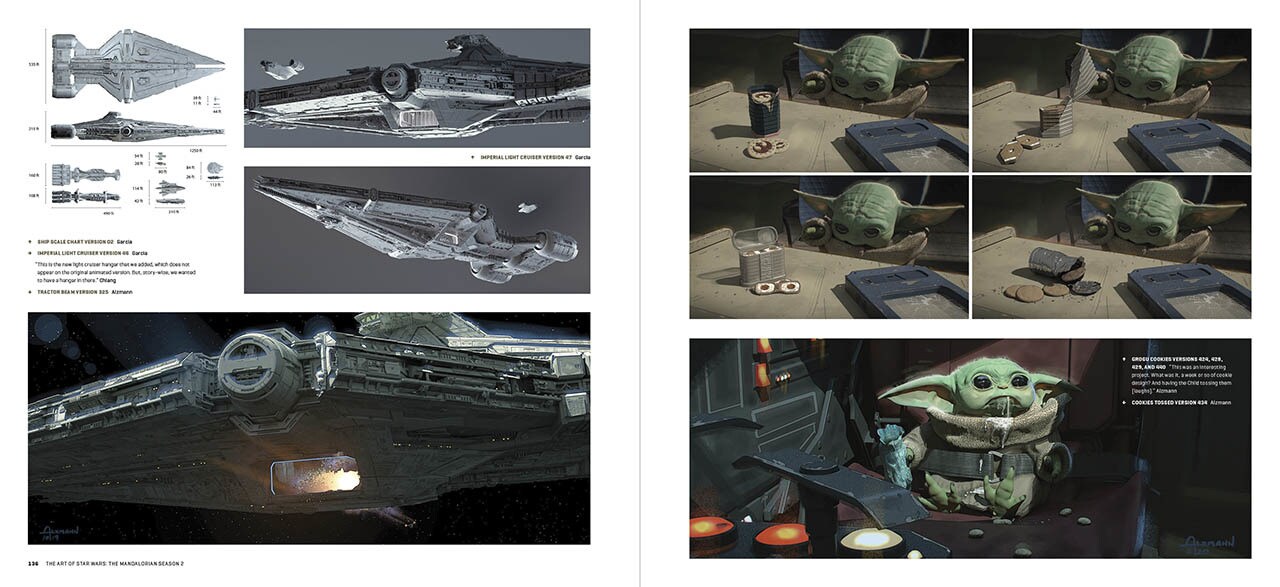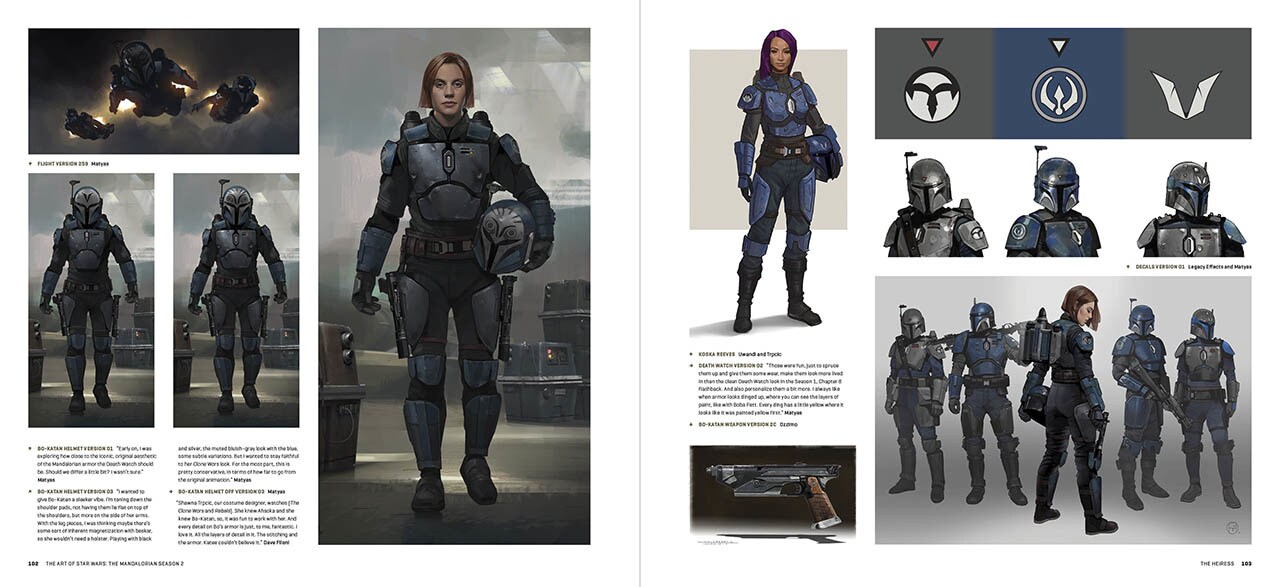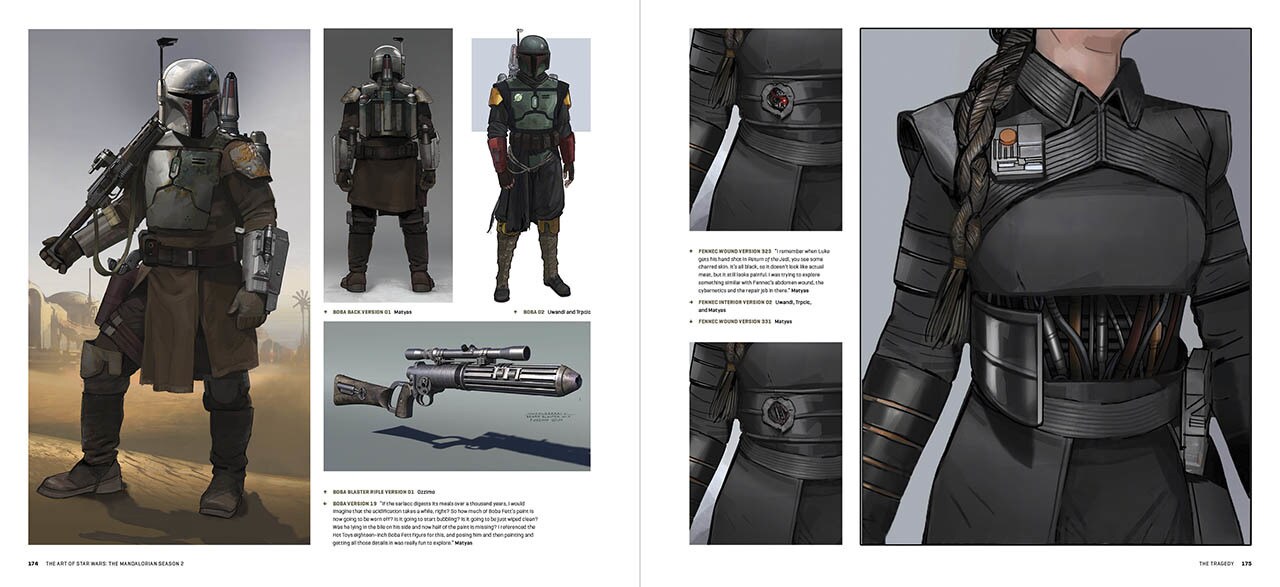Like all of us, Lucasfilm creative art manager Phil Szostak has spent much of the past two years at home. But unlike most of us, he wrote another book: The Art of The Mandalorian (Season 2), which takes fans inside the creation of the concept art that brought The Mandalorian’s second season on Disney+ to life.
Szostak has worked on a number of concept art books that tell the design stories behind Star Wars, but this one brought its own unique set of challenges.
“This is the first book I’ve ever written on my laptop at home,” Szostak tells StarWars.com. “That was a new experience, and definitely a challenge.”
And though he struggled to choose one, Szostak did let us in on his favorite image from this year’s book, which publishes February 15, 2022.
In an exclusive interview with StarWars.com, Szostak takes us inside the designs of the krayt dragon, the challenges of bringing beloved characters Ahsoka Tano and Luke Skywalker to life in the world of The Mandalorian, and tells us how he defines the visual aesthetic of Star Wars.
StarWars.com: How did working on the Season 2 book compare to doing it for Season 1?
Phil Szostak: It's not totally different. The art department rolled from one season to the other. I think one of the biggest struggles with writing one of these books is just going back in time, and remembering the sequence of events, especially in the midst of the pandemic lockdown.
I started this book last September. This is the first book I've ever written on my work laptop at home, talking to everyone on Zoom calls or on the phone. So, that was a new experience and definitely a challenge.
StarWars.com: So, I'm going to ask you to go back in time again! [Laughs] I think one of the things I really loved about the second season was I felt like it was this really wonderful mix of familiar places and experiences with completely new ones. Thinking about like a place like Tatooine, which is a well-trod planet, I suppose, for Star Wars fans, and yet we had a completely new experience there. From an art perspective, how did everyone go about really building out this Western outpost in Mos Pelgo?
Phil Szostak: That was a particular challenge. [Lucasfilm VP and executive creative director] Doug [Chiang] expresses it in the book. It would have been so easy for them to just lean on the history of the design of that place, which was influenced by Tunisian architecture -- which has now become fully integrated into the architectural aesthetic of Star Wars in general -- and focus mostly on where the filming locations were near the island of Djerba. Those very specific buildings there that have those like, soft corners and buttresses on the outside and all that stuff. It's just become such an integral part of Star Wars. And that was just a function of where they found themselves shooting the first film.
I think looking for something different and letting the story kind of lead the way in a sense [was the method]. You know, this krayt dragon plowing its way under the town and down the main street lends itself to the idea of raised boardwalks. Just bringing that boardwalk aesthetic alone is reflective of a lot of Western films. And the Western aesthetic is a huge part of Tatooine in general. Putting those pieces together and creating this fairly unique-looking, one-bantha town that was also a pretty typical Western frontier town. There's one street down the middle of it. And we have really a handful of buildings, and then it peters out. And giving that sense that these are people that are having to personally deal with this crisis because they're so remote and far away from the more populous cities.
It's a feedback loop that we're always nurturing, between the writing and art. So that was kind of a nice evolution, and, you know, a way to both honor the aesthetic of Tatooine and make sure that fans felt grounded in something that they already knew, but also bring something new to it.
StarWars.com: So, you mentioned the krayt dragon! [Laughs] For me, that was one of the most visually stunning moments in the season. And it's something new and also familiar, right? But it's a visual that I haven't seen before. How do you create something like that conceptually and decide what it’s going to look like?
Phil Szostak: That was one of the biggest design challenges of the whole season. There had been some previous design for what a krayt dragon could be because they have been a part of Star Wars since the very beginning. The skeleton C-3PO trundled by [in Star Wars: A New Hope] are krayt dragon bones.
There had also been some previous designs for what they might look like from both [Ralph] McQuarrie and Terryl Whitlatch, the prequel creature designer who primarily worked on Episode I on the creatures of Naboo and Tatooine. So, we were definitely trying to honor that work, as to what a krayt dragon could be, but then also bringing it to the modern era, and make something that was a real threat. They tried a bunch of different things -- horns, different scales, and ultimately set upon a very big scale. You can see some of that exploration in the book.
In a world of Star Wars mythology, that dragon is like a is a real mythological creature to fans, in the sense that they've heard about it and known about it for decades, and yet have not really seen it. Meeting those expectations, and at the same time meeting the needs of the story, was a challenge.
StarWars.com: Playing off of that, talking about the mythology of Star Wars and the lore, and that fan expectation, I think a character who embodied that is Ahsoka Tano. For fans of the animated series, obviously, they know who she is. But there are a lot of folks who also are coming to The Mandalorian, who may not have been as familiar with her, but there's so much hype. And so, because she’s existed in other mediums, there's an image of what she looks like. But how do you bring such a beloved character to life in a live-action arena where she has not previously existed?
Phil Szostak: Yeah, and that was another tremendous challenge, in some ways much more so than the krayt dragon. Translating a beloved animated character like that into live action is definitely a difficult task. And talk about expectations! I think [director, executive producer] Dave Filoni, in particular, being the person who co-created her and was shepherding her moving from animation to live action, felt a huge weight of responsibility to bring her to life in a way that honors everything that people already love about her.
To honor what came before but at the same time, not feel like you have to match it perfectly, isn’t easy. There's a huge difference between how something can be portrayed in animation versus live action, even just in color. We needed her to look real while still bringing everything that people love about her.
StarWars.com: I asked you this last time, but I'm curious. For this book, what is your favorite image?
Phil Szostak: Honestly, it's not just because we're talking about Ahsoka now, but it's literally because I think some of the most beautiful paintings in the book are from that chapter. The one that leads off that chapter with Ahsoka confronting the magistrate. Brian Matias’ paintings are really so beautiful, and he captures these characters so wonderfully. And that piece in particular is definitely one of my favorites -- page 138. It’s just a really awesome image. I just love that part of the book in general, and the pieces from that episode.
StarWars.com: We’ve talked about big moments as far as Ahsoka and the krayt dragon. But we haven't brought up arguably the biggest moment for some folks. Which, of course, is Luke Skywalker showing up at the end of the season, which I would imagine presented its own unique design and artistic challenges given that, unlike the sequel trilogy, where you could plug Mark Hamill in, you can't really do that when he's supposed to be [younger]. So how does the art team approach meeting that demand?
Phil Szostak: As you can see in the book, no art that really clearly depicted Luke was actually created. And honestly, some artists were left completely in the dark up until the episode aired. It was really only a small group of us that knew all along. There was no mention of Luke in the script, either. It was all Plo Koon. But there's that one image in the book where it’s Plo Koon in Luke’s robe and it’s like, “Hmmm.” [Laughs] And Plo Koon surviving makes a lot less sense than Luke, who we know is still around.
But yeah, for Luke, especially the aesthetic of his look is just about being faithful to what you know. But it's more what you think you know, versus what it actually is. It’s almost like an elevation or a sketch of your memory versus being exactly, precisely one-to-one with the last time we saw him in the timeline, which would have been, you know, Return of the Jedi, and the supplemental narrative material that he was in for Battlefront II.
You don't want to just assume that Luke only has like, one pair of clothes. [Laughs] So, you know, something that would be appropriate to who Luke was, and that's recognizable and as iconic as his Jedi look in Return of the Jedi. But also updating it and bringing it to the modern age, and just making slight tweaks. It's that balance between remaining faithful yet bringing something new to it, or just translating it into something that will work for the purposes of this particular show.
StarWars.com: You’ve mentioned the idea of a Star Wars aesthetic, and certain images over time that have come to define what Star Wars looks like. For you, how do you define that Star Wars aesthetic?
Phil Szostak: It's funny you mentioned that, because I've actually been working on a presentation that I'm giving on the aesthetic of the High Republic era. And it's a bit of a tricky thing, because if you want to think about it very simply, it's just all the things that George Lucas loves, visually, and throw them all in the bag, and like, shake it all up, and something falls out. And it's kind of Star Wars-y.
But one of the most important aspects of it to remember is that Star Wars is space fantasy. It's not science fiction. It's not futuristic. It's not something that's hard to relate to, because it's so alien and so wildly modern and futuristic, like a lot of science fiction that preceded it. That’s because it's science fantasy, or space fantasy. It's historic in nature and cultural in nature. So, it's got to be something that's relatable, which then makes it easy to visually read. And that's, I think, the core of the Star Wars aesthetic.






















